BTEC HND Unit 26: Change Management in Healthcare Services Report
VerifiedAdded on 2022/12/03
|16
|3541
|408
Report
AI Summary
This report provides a comprehensive analysis of change management within the healthcare sector, specifically focusing on the context of the RUH Bath NHS Trust. The introduction emphasizes the importance of change management for improving healthcare quality and efficiency. The report delves into the key factors driving change, distinguishing between internal factors like management viewpoints and external factors such as patient expectations and technological advancements. It also addresses the challenges of change management, including staff resistance, communication issues, budget constraints, and resource limitations, as well as the importance of measuring changes. The report examines recent changes in healthcare, including strategies and standards for measuring them, and proposes service responses to address identified issues, such as the need for a quality monitoring unit and robust human resource management strategies. Furthermore, the report outlines the principles of change management, including Kotter's 8-step model, and discusses the emotional and conditional aspects of change, highlighting the importance of creating a climate for change and engaging the organization. The report concludes by reiterating the significance of effective change management for the ongoing improvement of healthcare services.

Change Management in Health care
student
6/26/2019
student
6/26/2019
Paraphrase This Document
Need a fresh take? Get an instant paraphrase of this document with our AI Paraphraser
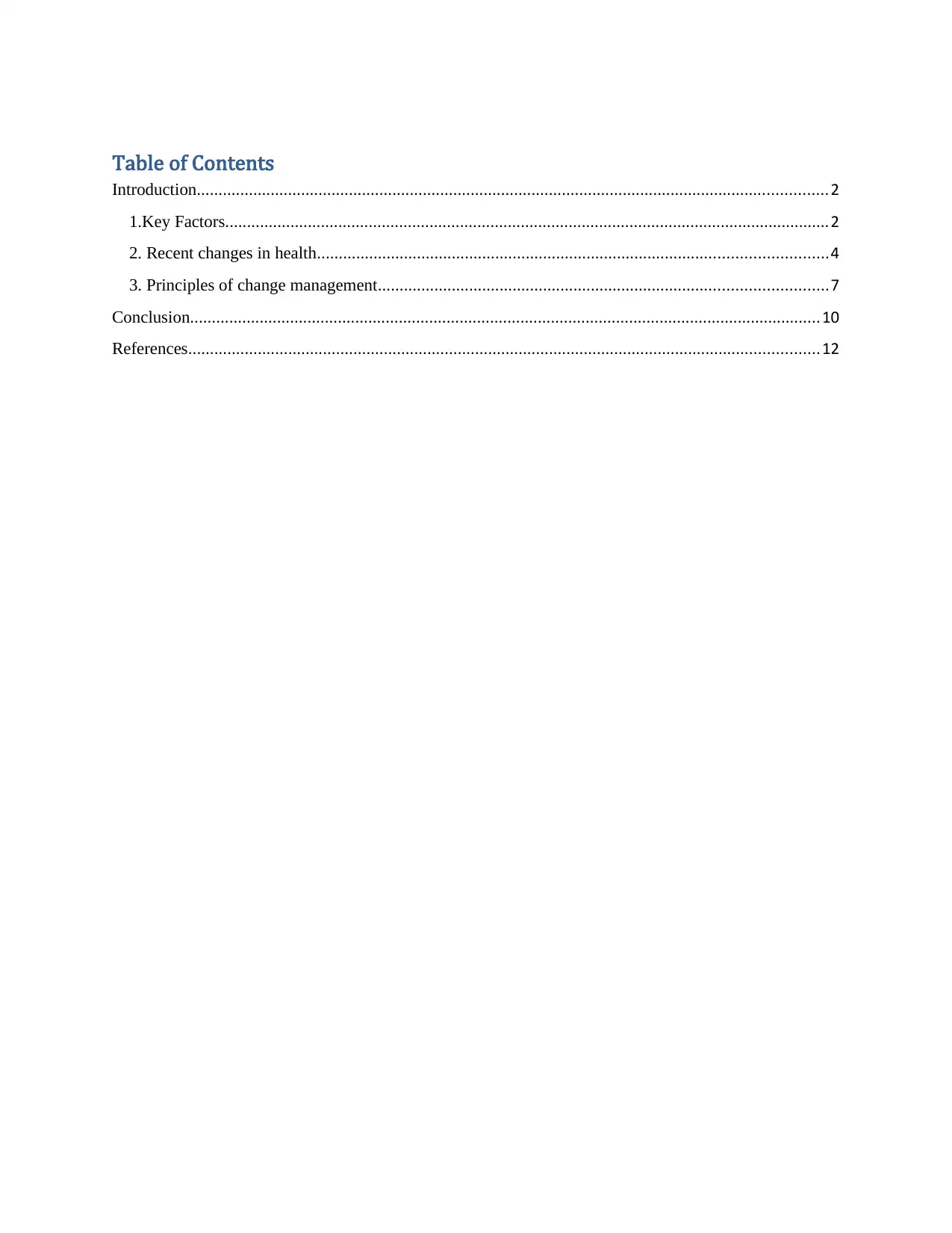
Table of Contents
Introduction.................................................................................................................................................2
1.Key Factors...........................................................................................................................................2
2. Recent changes in health.....................................................................................................................4
3. Principles of change management.......................................................................................................7
Conclusion.................................................................................................................................................10
References.................................................................................................................................................12
Introduction.................................................................................................................................................2
1.Key Factors...........................................................................................................................................2
2. Recent changes in health.....................................................................................................................4
3. Principles of change management.......................................................................................................7
Conclusion.................................................................................................................................................10
References.................................................................................................................................................12
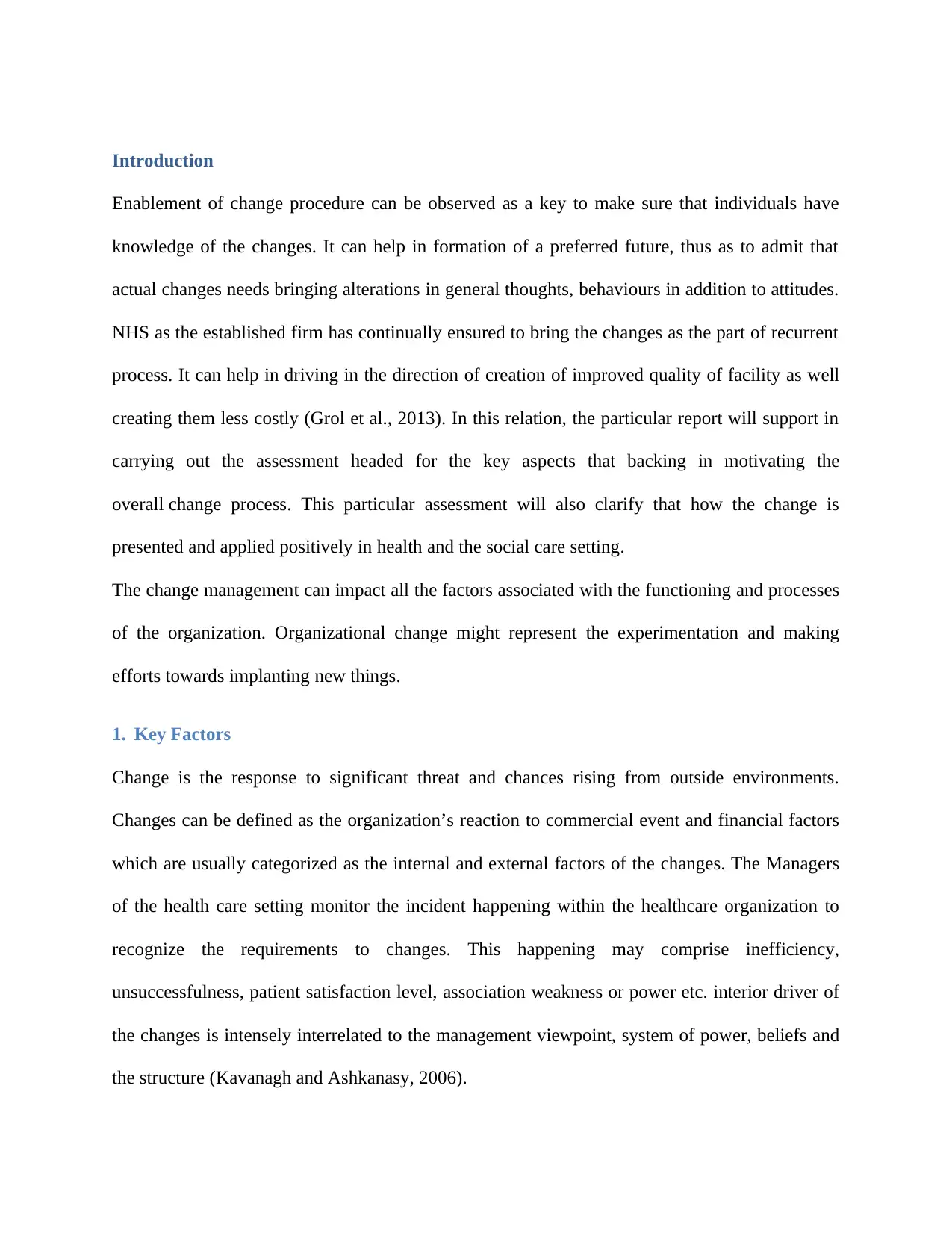
Introduction
Enablement of change procedure can be observed as a key to make sure that individuals have
knowledge of the changes. It can help in formation of a preferred future, thus as to admit that
actual changes needs bringing alterations in general thoughts, behaviours in addition to attitudes.
NHS as the established firm has continually ensured to bring the changes as the part of recurrent
process. It can help in driving in the direction of creation of improved quality of facility as well
creating them less costly (Grol et al., 2013). In this relation, the particular report will support in
carrying out the assessment headed for the key aspects that backing in motivating the
overall change process. This particular assessment will also clarify that how the change is
presented and applied positively in health and the social care setting.
The change management can impact all the factors associated with the functioning and processes
of the organization. Organizational change might represent the experimentation and making
efforts towards implanting new things.
1. Key Factors
Change is the response to significant threat and chances rising from outside environments.
Changes can be defined as the organization’s reaction to commercial event and financial factors
which are usually categorized as the internal and external factors of the changes. The Managers
of the health care setting monitor the incident happening within the healthcare organization to
recognize the requirements to changes. This happening may comprise inefficiency,
unsuccessfulness, patient satisfaction level, association weakness or power etc. interior driver of
the changes is intensely interrelated to the management viewpoint, system of power, beliefs and
the structure (Kavanagh and Ashkanasy, 2006).
Enablement of change procedure can be observed as a key to make sure that individuals have
knowledge of the changes. It can help in formation of a preferred future, thus as to admit that
actual changes needs bringing alterations in general thoughts, behaviours in addition to attitudes.
NHS as the established firm has continually ensured to bring the changes as the part of recurrent
process. It can help in driving in the direction of creation of improved quality of facility as well
creating them less costly (Grol et al., 2013). In this relation, the particular report will support in
carrying out the assessment headed for the key aspects that backing in motivating the
overall change process. This particular assessment will also clarify that how the change is
presented and applied positively in health and the social care setting.
The change management can impact all the factors associated with the functioning and processes
of the organization. Organizational change might represent the experimentation and making
efforts towards implanting new things.
1. Key Factors
Change is the response to significant threat and chances rising from outside environments.
Changes can be defined as the organization’s reaction to commercial event and financial factors
which are usually categorized as the internal and external factors of the changes. The Managers
of the health care setting monitor the incident happening within the healthcare organization to
recognize the requirements to changes. This happening may comprise inefficiency,
unsuccessfulness, patient satisfaction level, association weakness or power etc. interior driver of
the changes is intensely interrelated to the management viewpoint, system of power, beliefs and
the structure (Kavanagh and Ashkanasy, 2006).
⊘ This is a preview!⊘
Do you want full access?
Subscribe today to unlock all pages.

Trusted by 1+ million students worldwide

Things happening outside the healthcare organization may also impacts the change. These
specific factors might comprise changes in the expectation and needs of servicer consumer,
technological alterations, contestant action, superiority standard, legislature and political actions.
Based on the present status of the organization and purposes, the healthcare organization always
react to these aspect in dissimilar means which might counting changing approach, procedures or
even leading organizational extensive change. For example, in the selected case scenario, failure
to encounter the quality standard required the care superiority commission to request for changes
in the RUH bath NHS trust hospital (Ginter, Duncan and Swayne, 2018).
To recognize both the internal and outside factor of the changes, it is significant that healthcare
setting repeatedly observe their setting both within and external. This can be done by SWOT
analysis which identifies strengths, weaknesses, opportunities and threats related to the
organization. .
Example; External factor: The pressure placed on RUH bath trust by the CQC to implement
changes could have been evaded, if they have done continues monitoring their environment This
would have assisted the Trust to recognize its weakness (i.e. incapability to meet nationwide
standards) in improved and institute essential step/ measure to change the condition way before
they raised and they would have avoided the notice they received (Hayes, 2018).
Internal factors: Internal aspects of the changes are actually all those aspects whose source can
be found to administrative choice, insight and action. the internal factor in this case was the
mangers did not identify the key issues and did not perform routine checks.
1.2 Challenges
specific factors might comprise changes in the expectation and needs of servicer consumer,
technological alterations, contestant action, superiority standard, legislature and political actions.
Based on the present status of the organization and purposes, the healthcare organization always
react to these aspect in dissimilar means which might counting changing approach, procedures or
even leading organizational extensive change. For example, in the selected case scenario, failure
to encounter the quality standard required the care superiority commission to request for changes
in the RUH bath NHS trust hospital (Ginter, Duncan and Swayne, 2018).
To recognize both the internal and outside factor of the changes, it is significant that healthcare
setting repeatedly observe their setting both within and external. This can be done by SWOT
analysis which identifies strengths, weaknesses, opportunities and threats related to the
organization. .
Example; External factor: The pressure placed on RUH bath trust by the CQC to implement
changes could have been evaded, if they have done continues monitoring their environment This
would have assisted the Trust to recognize its weakness (i.e. incapability to meet nationwide
standards) in improved and institute essential step/ measure to change the condition way before
they raised and they would have avoided the notice they received (Hayes, 2018).
Internal factors: Internal aspects of the changes are actually all those aspects whose source can
be found to administrative choice, insight and action. the internal factor in this case was the
mangers did not identify the key issues and did not perform routine checks.
1.2 Challenges
Paraphrase This Document
Need a fresh take? Get an instant paraphrase of this document with our AI Paraphraser
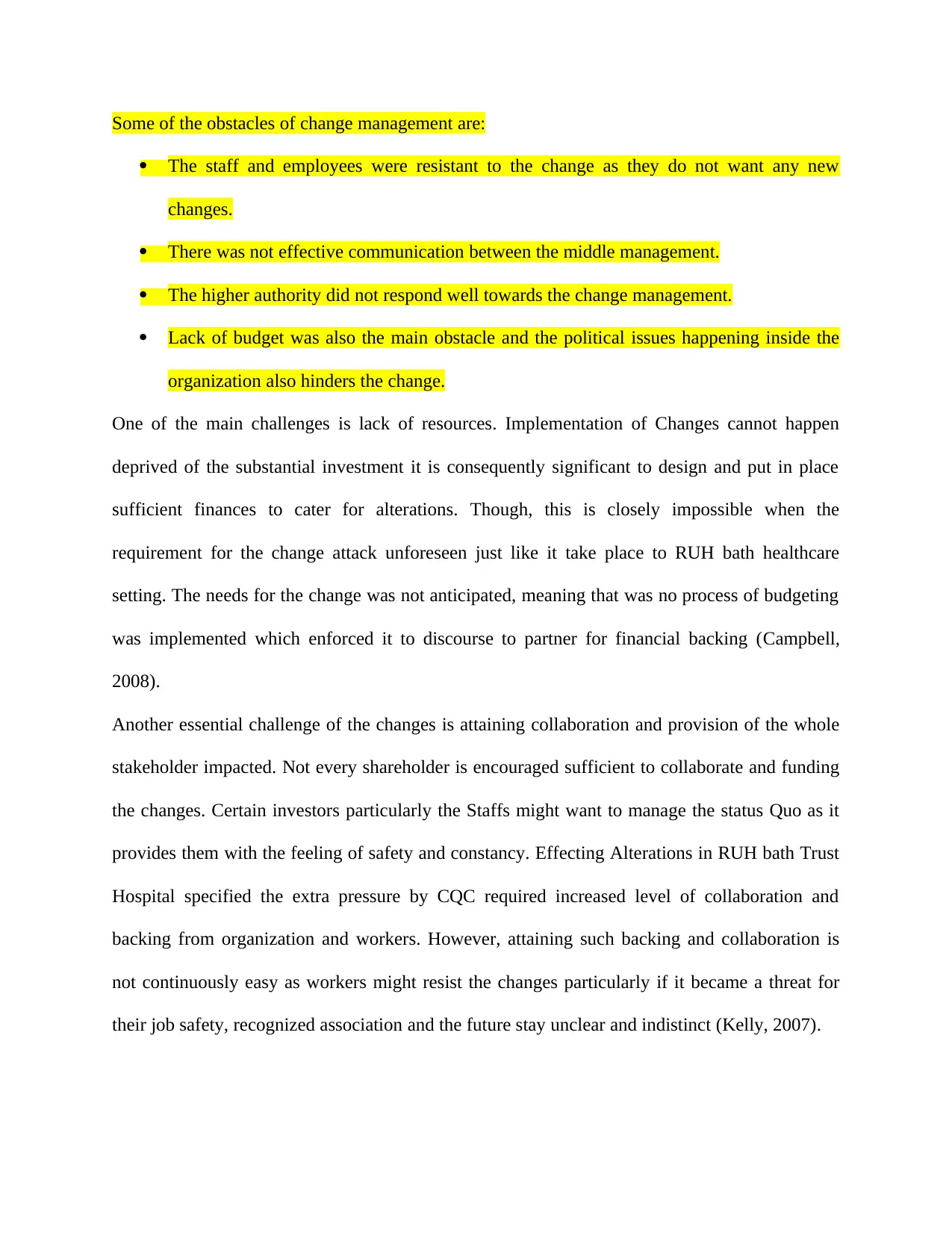
Some of the obstacles of change management are:
The staff and employees were resistant to the change as they do not want any new
changes.
There was not effective communication between the middle management.
The higher authority did not respond well towards the change management.
Lack of budget was also the main obstacle and the political issues happening inside the
organization also hinders the change.
One of the main challenges is lack of resources. Implementation of Changes cannot happen
deprived of the substantial investment it is consequently significant to design and put in place
sufficient finances to cater for alterations. Though, this is closely impossible when the
requirement for the change attack unforeseen just like it take place to RUH bath healthcare
setting. The needs for the change was not anticipated, meaning that was no process of budgeting
was implemented which enforced it to discourse to partner for financial backing (Campbell,
2008).
Another essential challenge of the changes is attaining collaboration and provision of the whole
stakeholder impacted. Not every shareholder is encouraged sufficient to collaborate and funding
the changes. Certain investors particularly the Staffs might want to manage the status Quo as it
provides them with the feeling of safety and constancy. Effecting Alterations in RUH bath Trust
Hospital specified the extra pressure by CQC required increased level of collaboration and
backing from organization and workers. However, attaining such backing and collaboration is
not continuously easy as workers might resist the changes particularly if it became a threat for
their job safety, recognized association and the future stay unclear and indistinct (Kelly, 2007).
The staff and employees were resistant to the change as they do not want any new
changes.
There was not effective communication between the middle management.
The higher authority did not respond well towards the change management.
Lack of budget was also the main obstacle and the political issues happening inside the
organization also hinders the change.
One of the main challenges is lack of resources. Implementation of Changes cannot happen
deprived of the substantial investment it is consequently significant to design and put in place
sufficient finances to cater for alterations. Though, this is closely impossible when the
requirement for the change attack unforeseen just like it take place to RUH bath healthcare
setting. The needs for the change was not anticipated, meaning that was no process of budgeting
was implemented which enforced it to discourse to partner for financial backing (Campbell,
2008).
Another essential challenge of the changes is attaining collaboration and provision of the whole
stakeholder impacted. Not every shareholder is encouraged sufficient to collaborate and funding
the changes. Certain investors particularly the Staffs might want to manage the status Quo as it
provides them with the feeling of safety and constancy. Effecting Alterations in RUH bath Trust
Hospital specified the extra pressure by CQC required increased level of collaboration and
backing from organization and workers. However, attaining such backing and collaboration is
not continuously easy as workers might resist the changes particularly if it became a threat for
their job safety, recognized association and the future stay unclear and indistinct (Kelly, 2007).
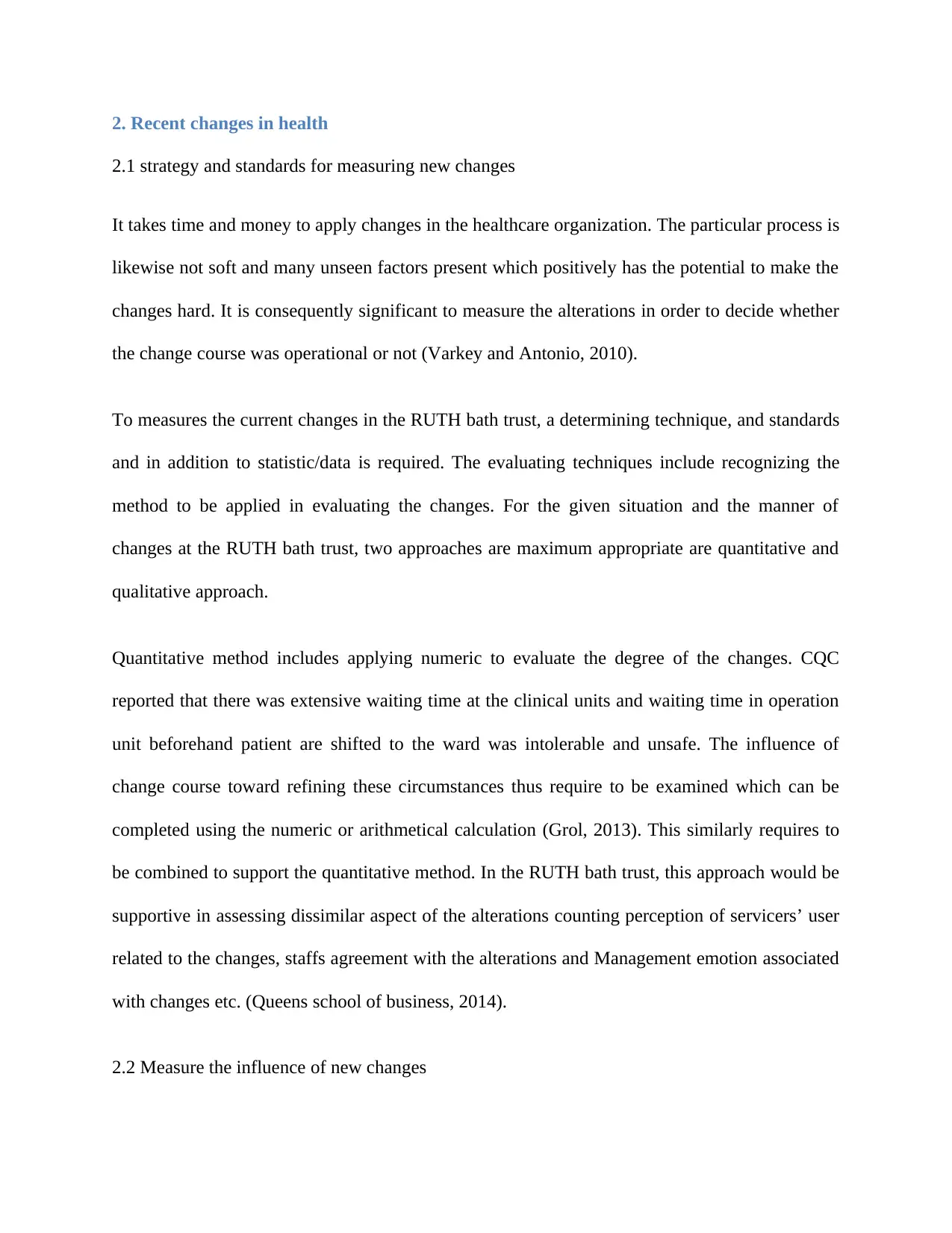
2. Recent changes in health
2.1 strategy and standards for measuring new changes
It takes time and money to apply changes in the healthcare organization. The particular process is
likewise not soft and many unseen factors present which positively has the potential to make the
changes hard. It is consequently significant to measure the alterations in order to decide whether
the change course was operational or not (Varkey and Antonio, 2010).
To measures the current changes in the RUTH bath trust, a determining technique, and standards
and in addition to statistic/data is required. The evaluating techniques include recognizing the
method to be applied in evaluating the changes. For the given situation and the manner of
changes at the RUTH bath trust, two approaches are maximum appropriate are quantitative and
qualitative approach.
Quantitative method includes applying numeric to evaluate the degree of the changes. CQC
reported that there was extensive waiting time at the clinical units and waiting time in operation
unit beforehand patient are shifted to the ward was intolerable and unsafe. The influence of
change course toward refining these circumstances thus require to be examined which can be
completed using the numeric or arithmetical calculation (Grol, 2013). This similarly requires to
be combined to support the quantitative method. In the RUTH bath trust, this approach would be
supportive in assessing dissimilar aspect of the alterations counting perception of servicers’ user
related to the changes, staffs agreement with the alterations and Management emotion associated
with changes etc. (Queens school of business, 2014).
2.2 Measure the influence of new changes
2.1 strategy and standards for measuring new changes
It takes time and money to apply changes in the healthcare organization. The particular process is
likewise not soft and many unseen factors present which positively has the potential to make the
changes hard. It is consequently significant to measure the alterations in order to decide whether
the change course was operational or not (Varkey and Antonio, 2010).
To measures the current changes in the RUTH bath trust, a determining technique, and standards
and in addition to statistic/data is required. The evaluating techniques include recognizing the
method to be applied in evaluating the changes. For the given situation and the manner of
changes at the RUTH bath trust, two approaches are maximum appropriate are quantitative and
qualitative approach.
Quantitative method includes applying numeric to evaluate the degree of the changes. CQC
reported that there was extensive waiting time at the clinical units and waiting time in operation
unit beforehand patient are shifted to the ward was intolerable and unsafe. The influence of
change course toward refining these circumstances thus require to be examined which can be
completed using the numeric or arithmetical calculation (Grol, 2013). This similarly requires to
be combined to support the quantitative method. In the RUTH bath trust, this approach would be
supportive in assessing dissimilar aspect of the alterations counting perception of servicers’ user
related to the changes, staffs agreement with the alterations and Management emotion associated
with changes etc. (Queens school of business, 2014).
2.2 Measure the influence of new changes
⊘ This is a preview!⊘
Do you want full access?
Subscribe today to unlock all pages.

Trusted by 1+ million students worldwide
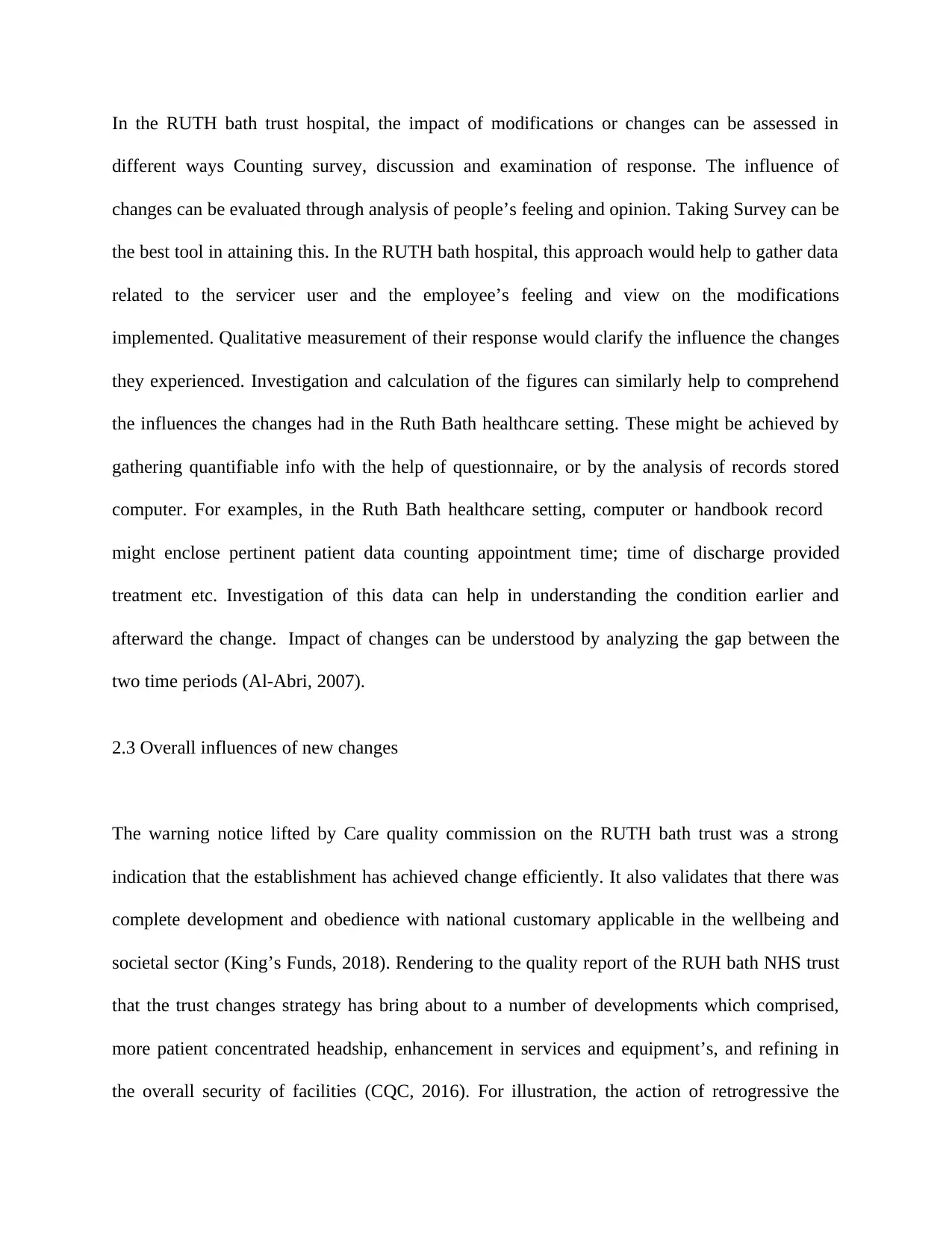
In the RUTH bath trust hospital, the impact of modifications or changes can be assessed in
different ways Counting survey, discussion and examination of response. The influence of
changes can be evaluated through analysis of people’s feeling and opinion. Taking Survey can be
the best tool in attaining this. In the RUTH bath hospital, this approach would help to gather data
related to the servicer user and the employee’s feeling and view on the modifications
implemented. Qualitative measurement of their response would clarify the influence the changes
they experienced. Investigation and calculation of the figures can similarly help to comprehend
the influences the changes had in the Ruth Bath healthcare setting. These might be achieved by
gathering quantifiable info with the help of questionnaire, or by the analysis of records stored
computer. For examples, in the Ruth Bath healthcare setting, computer or handbook record
might enclose pertinent patient data counting appointment time; time of discharge provided
treatment etc. Investigation of this data can help in understanding the condition earlier and
afterward the change. Impact of changes can be understood by analyzing the gap between the
two time periods (Al-Abri, 2007).
2.3 Overall influences of new changes
The warning notice lifted by Care quality commission on the RUTH bath trust was a strong
indication that the establishment has achieved change efficiently. It also validates that there was
complete development and obedience with national customary applicable in the wellbeing and
societal sector (King’s Funds, 2018). Rendering to the quality report of the RUH bath NHS trust
that the trust changes strategy has bring about to a number of developments which comprised,
more patient concentrated headship, enhancement in services and equipment’s, and refining in
the overall security of facilities (CQC, 2016). For illustration, the action of retrogressive the
different ways Counting survey, discussion and examination of response. The influence of
changes can be evaluated through analysis of people’s feeling and opinion. Taking Survey can be
the best tool in attaining this. In the RUTH bath hospital, this approach would help to gather data
related to the servicer user and the employee’s feeling and view on the modifications
implemented. Qualitative measurement of their response would clarify the influence the changes
they experienced. Investigation and calculation of the figures can similarly help to comprehend
the influences the changes had in the Ruth Bath healthcare setting. These might be achieved by
gathering quantifiable info with the help of questionnaire, or by the analysis of records stored
computer. For examples, in the Ruth Bath healthcare setting, computer or handbook record
might enclose pertinent patient data counting appointment time; time of discharge provided
treatment etc. Investigation of this data can help in understanding the condition earlier and
afterward the change. Impact of changes can be understood by analyzing the gap between the
two time periods (Al-Abri, 2007).
2.3 Overall influences of new changes
The warning notice lifted by Care quality commission on the RUTH bath trust was a strong
indication that the establishment has achieved change efficiently. It also validates that there was
complete development and obedience with national customary applicable in the wellbeing and
societal sector (King’s Funds, 2018). Rendering to the quality report of the RUH bath NHS trust
that the trust changes strategy has bring about to a number of developments which comprised,
more patient concentrated headship, enhancement in services and equipment’s, and refining in
the overall security of facilities (CQC, 2016). For illustration, the action of retrogressive the
Paraphrase This Document
Need a fresh take? Get an instant paraphrase of this document with our AI Paraphraser
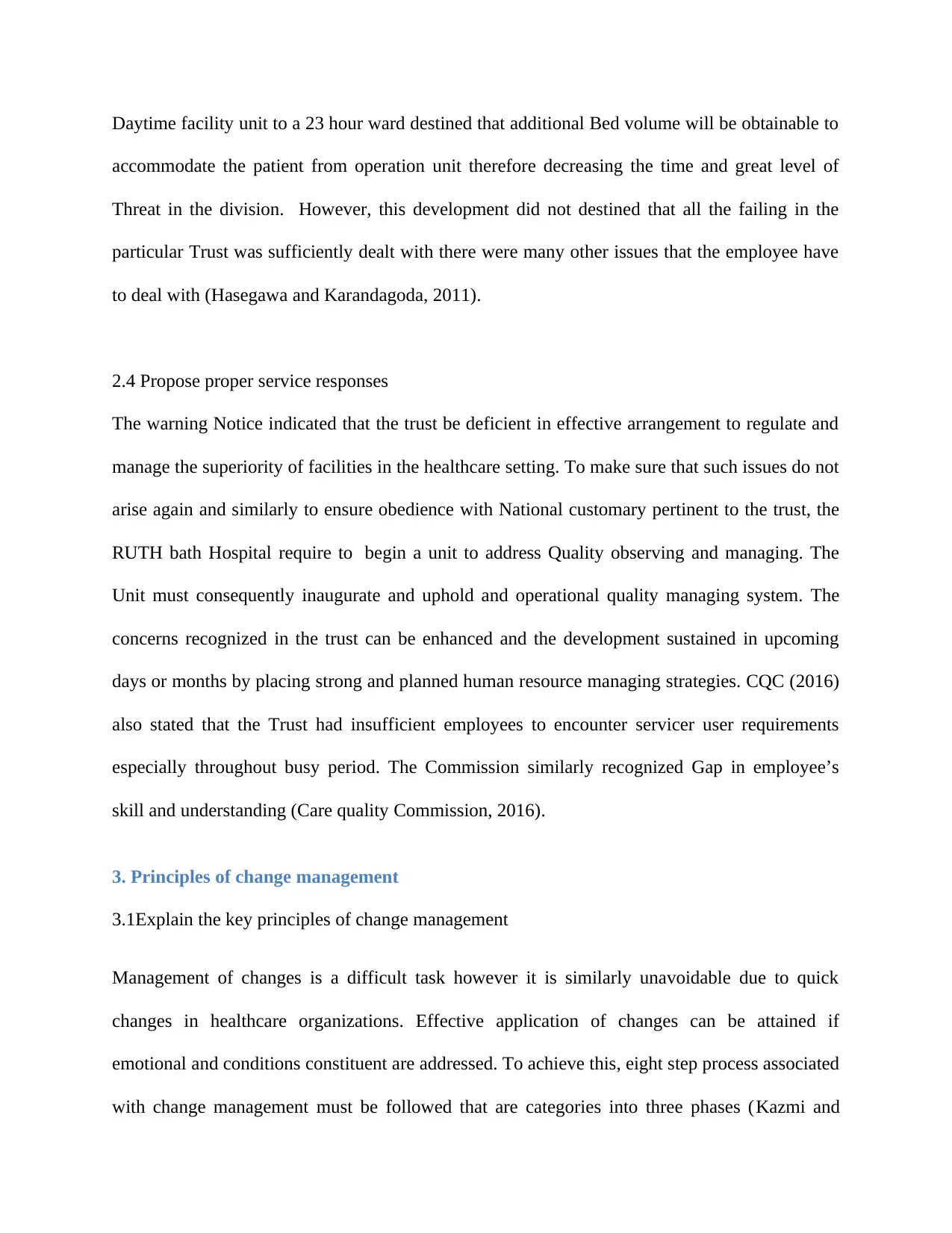
Daytime facility unit to a 23 hour ward destined that additional Bed volume will be obtainable to
accommodate the patient from operation unit therefore decreasing the time and great level of
Threat in the division. However, this development did not destined that all the failing in the
particular Trust was sufficiently dealt with there were many other issues that the employee have
to deal with (Hasegawa and Karandagoda, 2011).
2.4 Propose proper service responses
The warning Notice indicated that the trust be deficient in effective arrangement to regulate and
manage the superiority of facilities in the healthcare setting. To make sure that such issues do not
arise again and similarly to ensure obedience with National customary pertinent to the trust, the
RUTH bath Hospital require to begin a unit to address Quality observing and managing. The
Unit must consequently inaugurate and uphold and operational quality managing system. The
concerns recognized in the trust can be enhanced and the development sustained in upcoming
days or months by placing strong and planned human resource managing strategies. CQC (2016)
also stated that the Trust had insufficient employees to encounter servicer user requirements
especially throughout busy period. The Commission similarly recognized Gap in employee’s
skill and understanding (Care quality Commission, 2016).
3. Principles of change management
3.1Explain the key principles of change management
Management of changes is a difficult task however it is similarly unavoidable due to quick
changes in healthcare organizations. Effective application of changes can be attained if
emotional and conditions constituent are addressed. To achieve this, eight step process associated
with change management must be followed that are categories into three phases (Kazmi and
accommodate the patient from operation unit therefore decreasing the time and great level of
Threat in the division. However, this development did not destined that all the failing in the
particular Trust was sufficiently dealt with there were many other issues that the employee have
to deal with (Hasegawa and Karandagoda, 2011).
2.4 Propose proper service responses
The warning Notice indicated that the trust be deficient in effective arrangement to regulate and
manage the superiority of facilities in the healthcare setting. To make sure that such issues do not
arise again and similarly to ensure obedience with National customary pertinent to the trust, the
RUTH bath Hospital require to begin a unit to address Quality observing and managing. The
Unit must consequently inaugurate and uphold and operational quality managing system. The
concerns recognized in the trust can be enhanced and the development sustained in upcoming
days or months by placing strong and planned human resource managing strategies. CQC (2016)
also stated that the Trust had insufficient employees to encounter servicer user requirements
especially throughout busy period. The Commission similarly recognized Gap in employee’s
skill and understanding (Care quality Commission, 2016).
3. Principles of change management
3.1Explain the key principles of change management
Management of changes is a difficult task however it is similarly unavoidable due to quick
changes in healthcare organizations. Effective application of changes can be attained if
emotional and conditions constituent are addressed. To achieve this, eight step process associated
with change management must be followed that are categories into three phases (Kazmi and
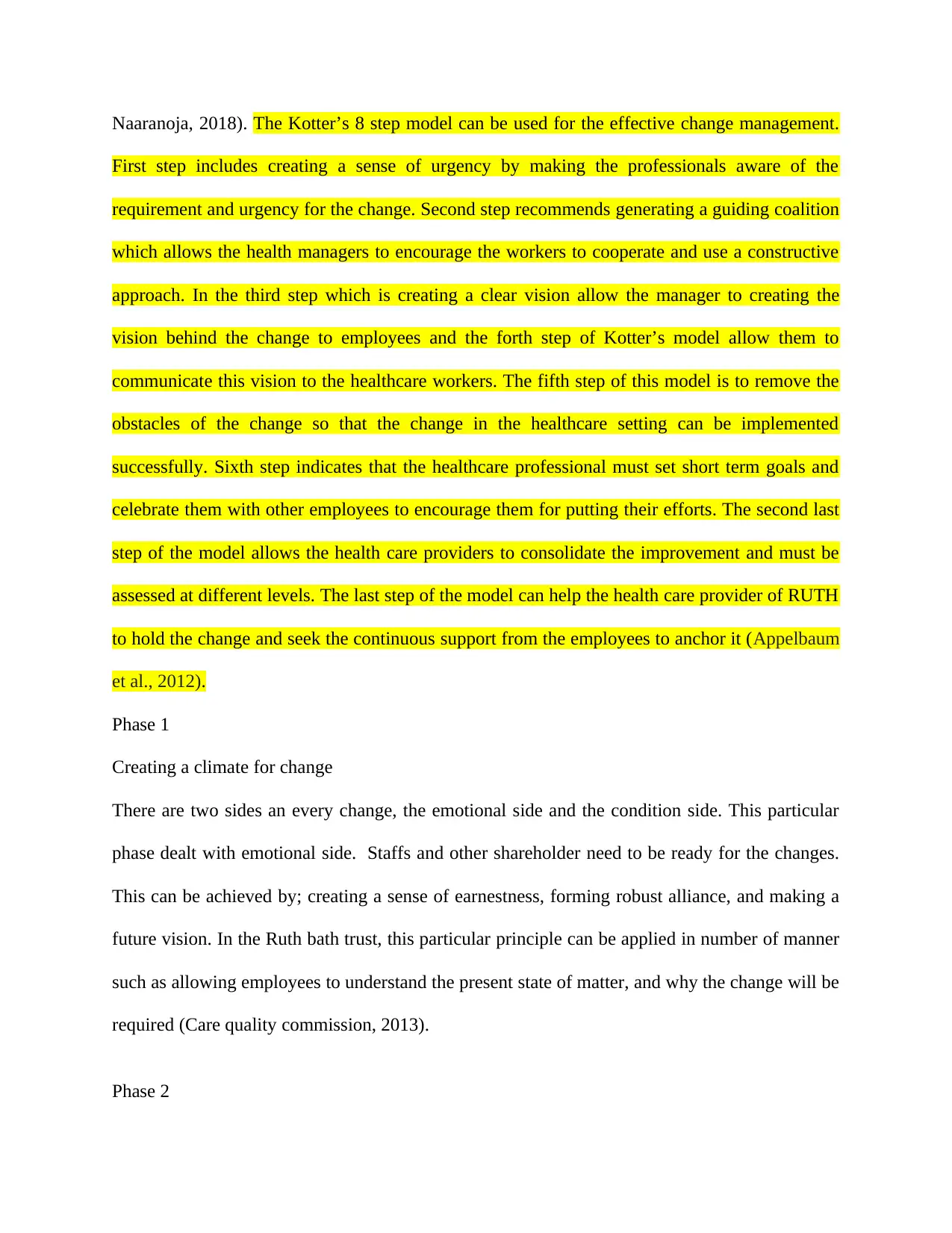
Naaranoja, 2018). The Kotter’s 8 step model can be used for the effective change management.
First step includes creating a sense of urgency by making the professionals aware of the
requirement and urgency for the change. Second step recommends generating a guiding coalition
which allows the health managers to encourage the workers to cooperate and use a constructive
approach. In the third step which is creating a clear vision allow the manager to creating the
vision behind the change to employees and the forth step of Kotter’s model allow them to
communicate this vision to the healthcare workers. The fifth step of this model is to remove the
obstacles of the change so that the change in the healthcare setting can be implemented
successfully. Sixth step indicates that the healthcare professional must set short term goals and
celebrate them with other employees to encourage them for putting their efforts. The second last
step of the model allows the health care providers to consolidate the improvement and must be
assessed at different levels. The last step of the model can help the health care provider of RUTH
to hold the change and seek the continuous support from the employees to anchor it (Appelbaum
et al., 2012).
Phase 1
Creating a climate for change
There are two sides an every change, the emotional side and the condition side. This particular
phase dealt with emotional side. Staffs and other shareholder need to be ready for the changes.
This can be achieved by; creating a sense of earnestness, forming robust alliance, and making a
future vision. In the Ruth bath trust, this particular principle can be applied in number of manner
such as allowing employees to understand the present state of matter, and why the change will be
required (Care quality commission, 2013).
Phase 2
First step includes creating a sense of urgency by making the professionals aware of the
requirement and urgency for the change. Second step recommends generating a guiding coalition
which allows the health managers to encourage the workers to cooperate and use a constructive
approach. In the third step which is creating a clear vision allow the manager to creating the
vision behind the change to employees and the forth step of Kotter’s model allow them to
communicate this vision to the healthcare workers. The fifth step of this model is to remove the
obstacles of the change so that the change in the healthcare setting can be implemented
successfully. Sixth step indicates that the healthcare professional must set short term goals and
celebrate them with other employees to encourage them for putting their efforts. The second last
step of the model allows the health care providers to consolidate the improvement and must be
assessed at different levels. The last step of the model can help the health care provider of RUTH
to hold the change and seek the continuous support from the employees to anchor it (Appelbaum
et al., 2012).
Phase 1
Creating a climate for change
There are two sides an every change, the emotional side and the condition side. This particular
phase dealt with emotional side. Staffs and other shareholder need to be ready for the changes.
This can be achieved by; creating a sense of earnestness, forming robust alliance, and making a
future vision. In the Ruth bath trust, this particular principle can be applied in number of manner
such as allowing employees to understand the present state of matter, and why the change will be
required (Care quality commission, 2013).
Phase 2
⊘ This is a preview!⊘
Do you want full access?
Subscribe today to unlock all pages.

Trusted by 1+ million students worldwide
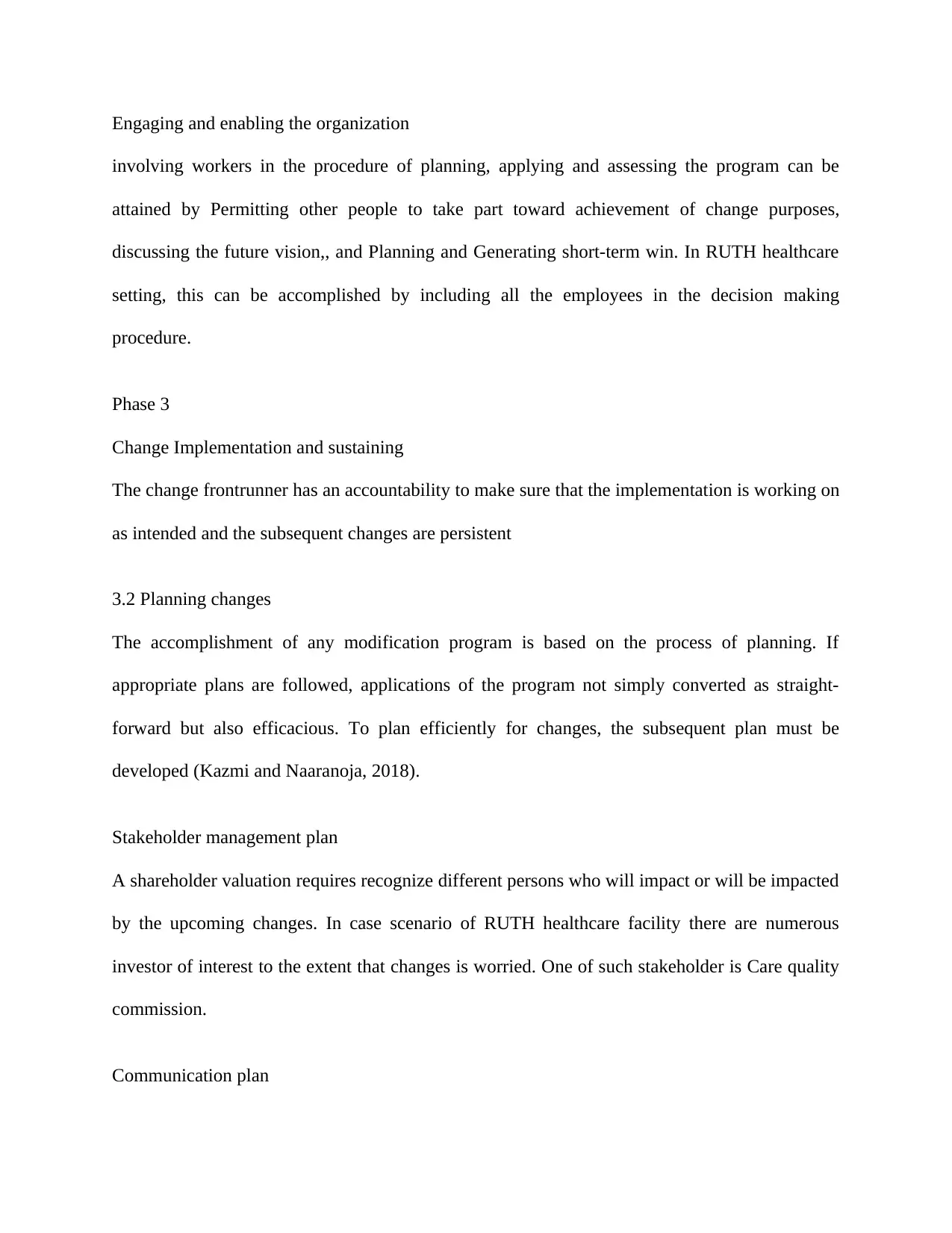
Engaging and enabling the organization
involving workers in the procedure of planning, applying and assessing the program can be
attained by Permitting other people to take part toward achievement of change purposes,
discussing the future vision,, and Planning and Generating short-term win. In RUTH healthcare
setting, this can be accomplished by including all the employees in the decision making
procedure.
Phase 3
Change Implementation and sustaining
The change frontrunner has an accountability to make sure that the implementation is working on
as intended and the subsequent changes are persistent
3.2 Planning changes
The accomplishment of any modification program is based on the process of planning. If
appropriate plans are followed, applications of the program not simply converted as straight-
forward but also efficacious. To plan efficiently for changes, the subsequent plan must be
developed (Kazmi and Naaranoja, 2018).
Stakeholder management plan
A shareholder valuation requires recognize different persons who will impact or will be impacted
by the upcoming changes. In case scenario of RUTH healthcare facility there are numerous
investor of interest to the extent that changes is worried. One of such stakeholder is Care quality
commission.
Communication plan
involving workers in the procedure of planning, applying and assessing the program can be
attained by Permitting other people to take part toward achievement of change purposes,
discussing the future vision,, and Planning and Generating short-term win. In RUTH healthcare
setting, this can be accomplished by including all the employees in the decision making
procedure.
Phase 3
Change Implementation and sustaining
The change frontrunner has an accountability to make sure that the implementation is working on
as intended and the subsequent changes are persistent
3.2 Planning changes
The accomplishment of any modification program is based on the process of planning. If
appropriate plans are followed, applications of the program not simply converted as straight-
forward but also efficacious. To plan efficiently for changes, the subsequent plan must be
developed (Kazmi and Naaranoja, 2018).
Stakeholder management plan
A shareholder valuation requires recognize different persons who will impact or will be impacted
by the upcoming changes. In case scenario of RUTH healthcare facility there are numerous
investor of interest to the extent that changes is worried. One of such stakeholder is Care quality
commission.
Communication plan
Paraphrase This Document
Need a fresh take? Get an instant paraphrase of this document with our AI Paraphraser
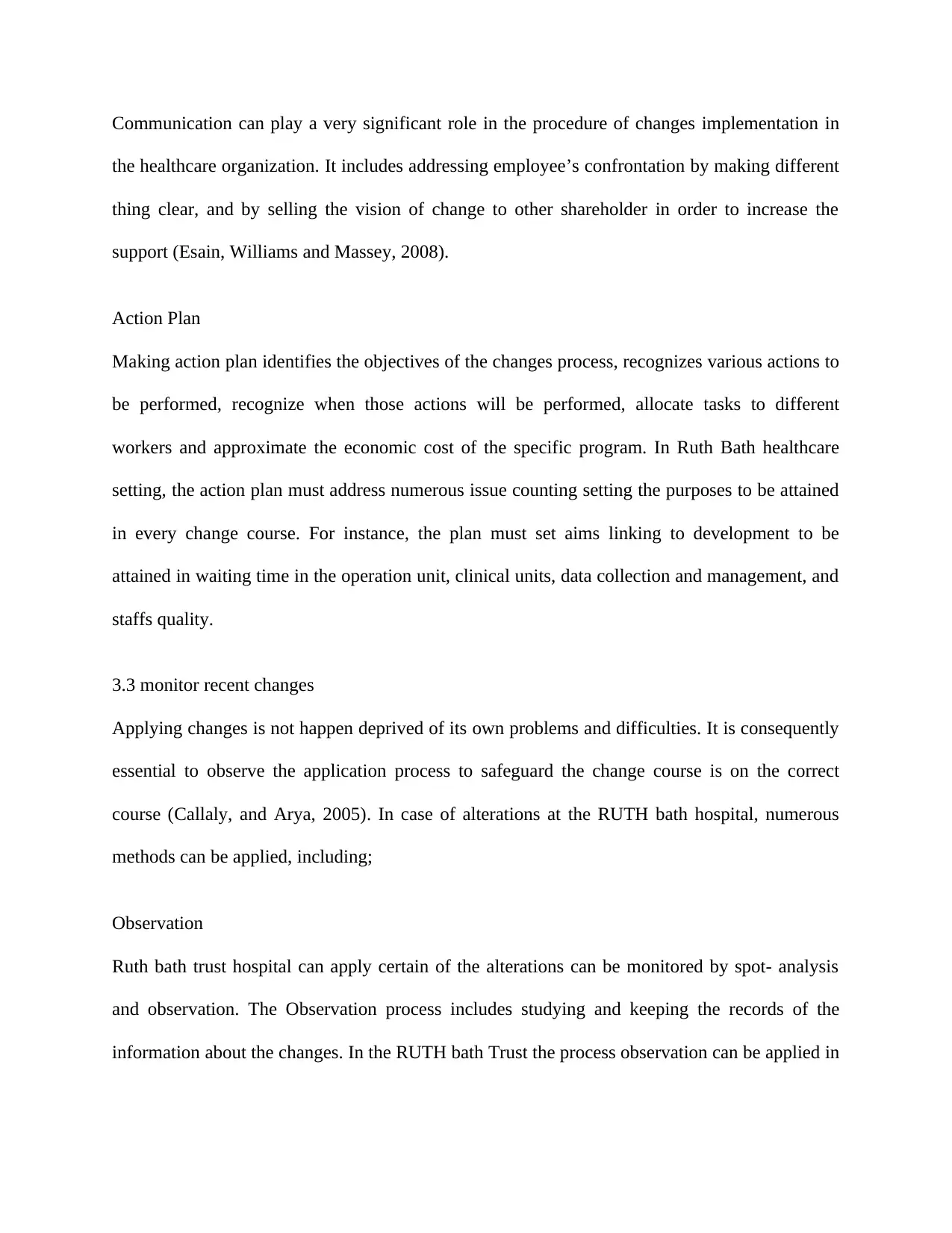
Communication can play a very significant role in the procedure of changes implementation in
the healthcare organization. It includes addressing employee’s confrontation by making different
thing clear, and by selling the vision of change to other shareholder in order to increase the
support (Esain, Williams and Massey, 2008).
Action Plan
Making action plan identifies the objectives of the changes process, recognizes various actions to
be performed, recognize when those actions will be performed, allocate tasks to different
workers and approximate the economic cost of the specific program. In Ruth Bath healthcare
setting, the action plan must address numerous issue counting setting the purposes to be attained
in every change course. For instance, the plan must set aims linking to development to be
attained in waiting time in the operation unit, clinical units, data collection and management, and
staffs quality.
3.3 monitor recent changes
Applying changes is not happen deprived of its own problems and difficulties. It is consequently
essential to observe the application process to safeguard the change course is on the correct
course (Callaly, and Arya, 2005). In case of alterations at the RUTH bath hospital, numerous
methods can be applied, including;
Observation
Ruth bath trust hospital can apply certain of the alterations can be monitored by spot- analysis
and observation. The Observation process includes studying and keeping the records of the
information about the changes. In the RUTH bath Trust the process observation can be applied in
the healthcare organization. It includes addressing employee’s confrontation by making different
thing clear, and by selling the vision of change to other shareholder in order to increase the
support (Esain, Williams and Massey, 2008).
Action Plan
Making action plan identifies the objectives of the changes process, recognizes various actions to
be performed, recognize when those actions will be performed, allocate tasks to different
workers and approximate the economic cost of the specific program. In Ruth Bath healthcare
setting, the action plan must address numerous issue counting setting the purposes to be attained
in every change course. For instance, the plan must set aims linking to development to be
attained in waiting time in the operation unit, clinical units, data collection and management, and
staffs quality.
3.3 monitor recent changes
Applying changes is not happen deprived of its own problems and difficulties. It is consequently
essential to observe the application process to safeguard the change course is on the correct
course (Callaly, and Arya, 2005). In case of alterations at the RUTH bath hospital, numerous
methods can be applied, including;
Observation
Ruth bath trust hospital can apply certain of the alterations can be monitored by spot- analysis
and observation. The Observation process includes studying and keeping the records of the
information about the changes. In the RUTH bath Trust the process observation can be applied in
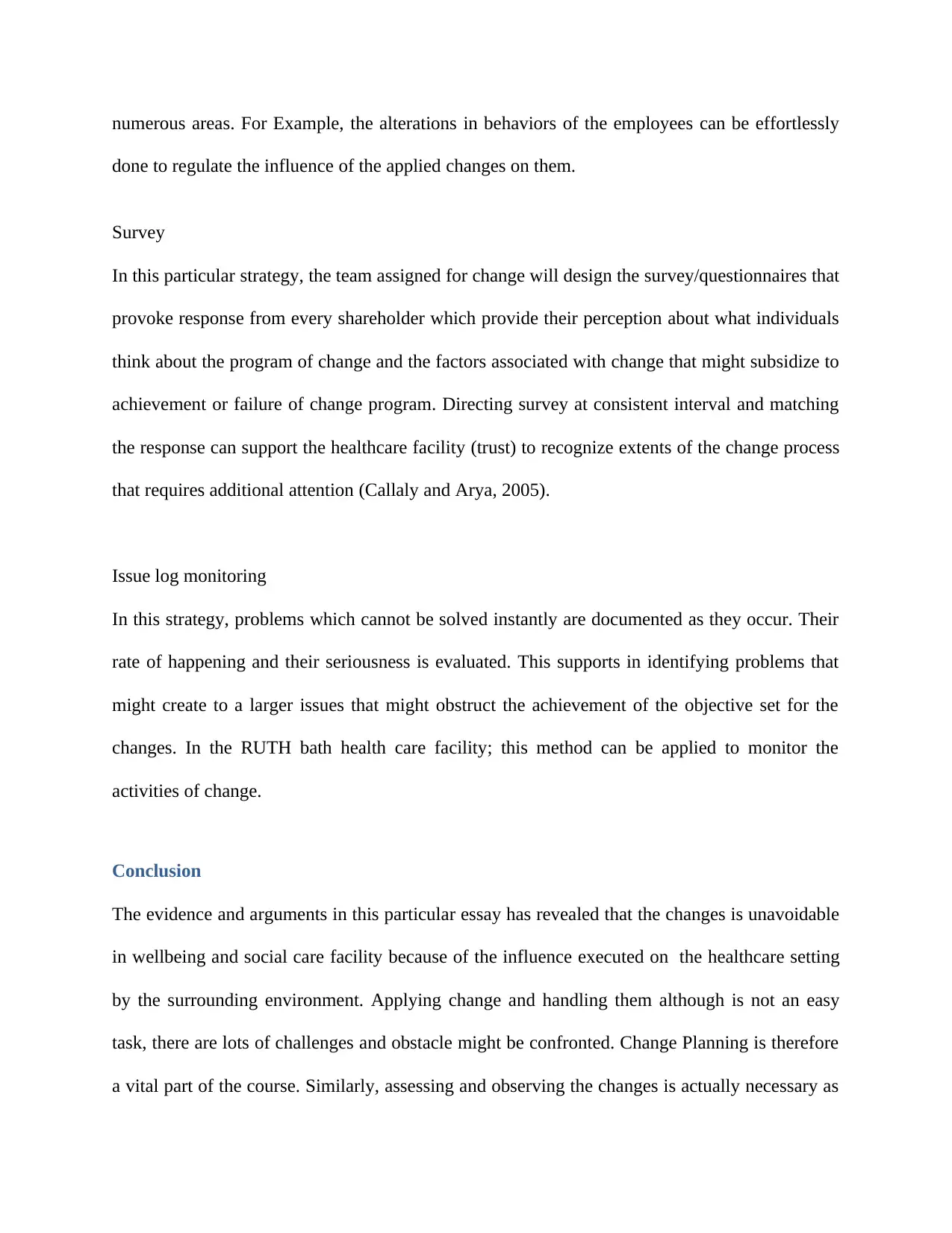
numerous areas. For Example, the alterations in behaviors of the employees can be effortlessly
done to regulate the influence of the applied changes on them.
Survey
In this particular strategy, the team assigned for change will design the survey/questionnaires that
provoke response from every shareholder which provide their perception about what individuals
think about the program of change and the factors associated with change that might subsidize to
achievement or failure of change program. Directing survey at consistent interval and matching
the response can support the healthcare facility (trust) to recognize extents of the change process
that requires additional attention (Callaly and Arya, 2005).
Issue log monitoring
In this strategy, problems which cannot be solved instantly are documented as they occur. Their
rate of happening and their seriousness is evaluated. This supports in identifying problems that
might create to a larger issues that might obstruct the achievement of the objective set for the
changes. In the RUTH bath health care facility; this method can be applied to monitor the
activities of change.
Conclusion
The evidence and arguments in this particular essay has revealed that the changes is unavoidable
in wellbeing and social care facility because of the influence executed on the healthcare setting
by the surrounding environment. Applying change and handling them although is not an easy
task, there are lots of challenges and obstacle might be confronted. Change Planning is therefore
a vital part of the course. Similarly, assessing and observing the changes is actually necessary as
done to regulate the influence of the applied changes on them.
Survey
In this particular strategy, the team assigned for change will design the survey/questionnaires that
provoke response from every shareholder which provide their perception about what individuals
think about the program of change and the factors associated with change that might subsidize to
achievement or failure of change program. Directing survey at consistent interval and matching
the response can support the healthcare facility (trust) to recognize extents of the change process
that requires additional attention (Callaly and Arya, 2005).
Issue log monitoring
In this strategy, problems which cannot be solved instantly are documented as they occur. Their
rate of happening and their seriousness is evaluated. This supports in identifying problems that
might create to a larger issues that might obstruct the achievement of the objective set for the
changes. In the RUTH bath health care facility; this method can be applied to monitor the
activities of change.
Conclusion
The evidence and arguments in this particular essay has revealed that the changes is unavoidable
in wellbeing and social care facility because of the influence executed on the healthcare setting
by the surrounding environment. Applying change and handling them although is not an easy
task, there are lots of challenges and obstacle might be confronted. Change Planning is therefore
a vital part of the course. Similarly, assessing and observing the changes is actually necessary as
⊘ This is a preview!⊘
Do you want full access?
Subscribe today to unlock all pages.

Trusted by 1+ million students worldwide
1 out of 16
Related Documents
Your All-in-One AI-Powered Toolkit for Academic Success.
+13062052269
info@desklib.com
Available 24*7 on WhatsApp / Email
![[object Object]](/_next/static/media/star-bottom.7253800d.svg)
Unlock your academic potential
Copyright © 2020–2025 A2Z Services. All Rights Reserved. Developed and managed by ZUCOL.





